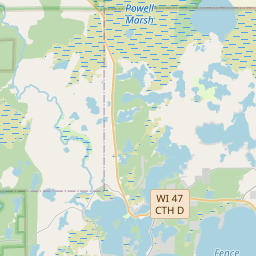Lac du Flambeau
Historical marker location:
Lac du Flambeau, Wisconsin
( Marker is on State Highway 47 south of Cemetery Road, on the left when traveling north.)
Marker installed: 1957






© OpenStreetMap contributors
Loading...
Searching for other points of interest within 3 miles of this location.The world's largest music festival, Summerfest, takes place in Milwaukee each year. It has been held annually since 1968 and features over 800 acts performing on 11 stages over 11 days.
About Vilas County
Vilas County Timeline
Vilas County, located in Northern Wisconsin, has a rich history that dates back to ancestral times. Before European settlement, the area was home to Native American tribes, including the Ojibwe and Potawatomi. These tribes relied on the region's abundant natural resources, such as forests, lakes, and rivers, for sustenance and trade.
In the mid-19th century, the first Europeans arrived in the area. Logging became a significant industry, as the dense forests provided an ample supply of timber. Lumberjacks, known as "river rats," would float logs down the numerous rivers to sawmills. This led to the development of small settlements, including Eagle River and Arbor Vitae, which became important centers of commerce and trade.
Vilas County started to flourish in the late 1800s with the arrival of the railroad. The Chicago and North Western Railway extended its line to the region, allowing for easier transportation of goods and people. This led to a surge in tourism as visitors discovered the breathtaking beauty of the area's lakes and forests. Hotels, resorts, and summer cottages began sprouting up along the lake shores, attracting tourists from nearby cities.
During the early 20th century, Vilas County gained recognition as a premier vacation destination. Outdoor activities such as fishing, boating, hunting, and skiing became popular among visitors. Famous figures like snowshoe maker George Washington Sears, also known as "Nessmuk," and naturalist John Muir, who spent time in the area, helped establish the county's reputation as a recreational paradise.
Today, Vilas County remains a beloved getaway for outdoor enthusiasts. With its pristine lakes, extensive trail systems, and vast forests, it continues to attract visitors seeking adventure and relaxation amidst the tranquility of nature. The county's rich history is still evident in its charming towns, museums, and cultural events, paying homage to its early settlers and the indigenous communities that originally called this area home.
In the mid-19th century, the first Europeans arrived in the area. Logging became a significant industry, as the dense forests provided an ample supply of timber. Lumberjacks, known as "river rats," would float logs down the numerous rivers to sawmills. This led to the development of small settlements, including Eagle River and Arbor Vitae, which became important centers of commerce and trade.
Vilas County started to flourish in the late 1800s with the arrival of the railroad. The Chicago and North Western Railway extended its line to the region, allowing for easier transportation of goods and people. This led to a surge in tourism as visitors discovered the breathtaking beauty of the area's lakes and forests. Hotels, resorts, and summer cottages began sprouting up along the lake shores, attracting tourists from nearby cities.
During the early 20th century, Vilas County gained recognition as a premier vacation destination. Outdoor activities such as fishing, boating, hunting, and skiing became popular among visitors. Famous figures like snowshoe maker George Washington Sears, also known as "Nessmuk," and naturalist John Muir, who spent time in the area, helped establish the county's reputation as a recreational paradise.
Today, Vilas County remains a beloved getaway for outdoor enthusiasts. With its pristine lakes, extensive trail systems, and vast forests, it continues to attract visitors seeking adventure and relaxation amidst the tranquility of nature. The county's rich history is still evident in its charming towns, museums, and cultural events, paying homage to its early settlers and the indigenous communities that originally called this area home.
Vilas County Timeline
This timeline provides a concise overview of the key events in the history of Vilas County, Wisconsin.
- 1840s: Native American tribes, including the Ojibwe, inhabit the region known today as Vilas County.
- 1850s: European settlers arrive in the area and establish logging camps.
- 1878: Vilas County is officially created, named after William Freeman Vilas, a prominent U.S. Senator from Wisconsin.
- 1880s: The logging industry booms, leading to rapid economic growth and the establishment of towns in the county.
- 1890s: The population of Vilas County continues to increase as tourism becomes popular, with visitors drawn to the region's abundant natural beauty and recreational opportunities.
- Early 1900s: Vilas County becomes known for its numerous lakes, attracting fishing enthusiasts and summer vacationers.
- 1920s: The county experiences a decline in logging activities, leading to a shift towards a more tourism-focused economy.
- 1940s-1950s: Vilas County contributes to the World War II effort through production and support services.
- 1960s-1970s: The county begins to diversify its tourism offerings, with the establishment of ski resorts and the promotion of winter sports.
- 1990s-2000s: Vilas County continues to attract tourists throughout the year, offering opportunities for recreational activities such as boating, hiking, fishing, and snowmobiling.